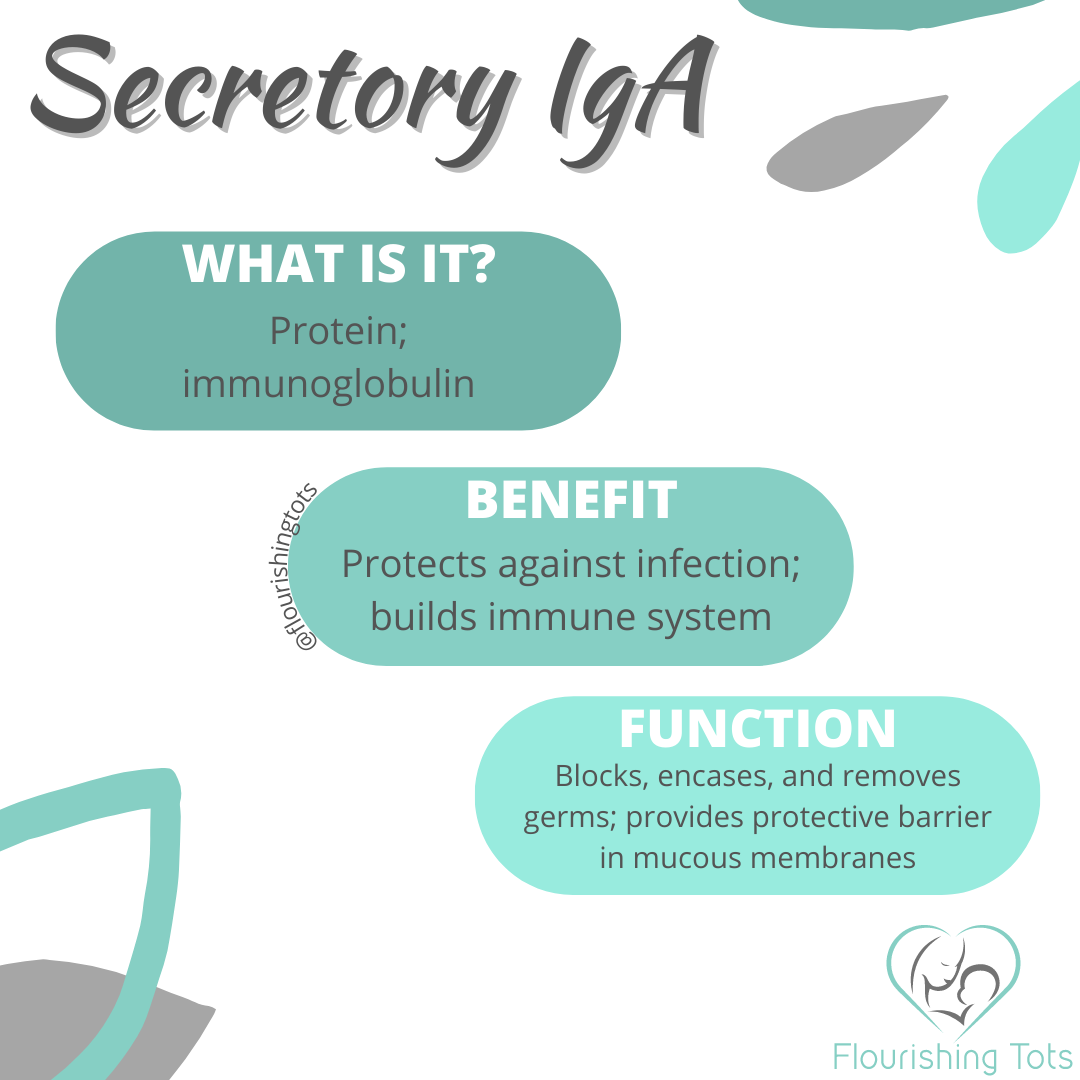Secretory IgA
Lactation Celebration Week Part 7! The final day. I chose something that’s on a lot of people’s mind…immune factors.
With COVID-19 still raging around the world, many people hope to provide their baby with immune protection via their milk, with or without them receiving a vaccine. While I do touch on Covid, my main focus was to provide information on one of the most abundant immune factors present in human milk.
Building a well-functioning immune system is imperative to protect babies from all diseases, including Covid.
What is it?
IgA is a type of immunoglobulin (Ig), a protein in the body which fights infection. There are two types of IgA, serum and secretory. Today’s blog is about secretory IgA.
Secretory IgA (SIgA) neutralizes viruses and exotoxins in addition to enhancing the activity of lactoferrin to inhibit microbial growth.
SIgA is found in mucosal secretions in the body. It is the most abundant, representing 90% of all immunoglobulins. Because SIgA contains a special coating, it is able to survive the digestive journey through stomach acid and carry out it’s immune building functions in the intestines.
Some SIgA is the same for all humans and provides general immunity to the baby. But a lot of the SIgA in milk varies depending on the parent’s current/past exposure to disease causing germs, particularly those that cause respiratory or intestinal infections.
Because babies don’t produce their own immunoglobulins for a few months, the immunoglobulins passed from parent to baby via human milk is the baby’s only external source of immune protection. The immune system isn’t completely mature until about 5 years of age, about the time of natural weaning.
How does it affect my baby?
Babies receive immunoglobulins and antibodies from the placenta during pregnancy. These substances last for weeks to months, depending on the type. Because newborns don’t make their own immune factors, they rely on human milk to continually build their immunity.
SIgA works by blocking, encasing, and removing intestinal pathogens from the body, mainly in the intestines, airway, and urinary tract (mucosal surfaces). These surfaces have just 1 layer of cells protecting the inside of your body from the outside world. SIgA provides a protective barrier for that layer of cells which prevents germs (bacteria, viruses, fungi, parasites) from entering the bloodstream.
SIgA has the ability to sniff out the bad bacteria while also preserving the good bacteria. This process encourages beneficial bacteria to grow and creates a healthy gut environment. These good bacteria are fed by oligosaccharides of which there are over 200 varieties that are only found in human milk.
Typically inflammation is present at the site of an infection or injury (think redness/swelling from an insect bite), but SIgA provides immune protection while being anti-inflammatory. This anti-inflammatory response protects the body from chronic diseases.
For preterm babies who are highly susceptible to necrotizing enterocolitis (NEC), SIgA is incredibly important for immune protection. In the intestines, SIgA binds to bacteria in order to prevent them from infecting the body. SIgA provides dose-dependent protection. The more SIgA in the baby’s intestines, the more bacteria it can bind to, thus lessening the risk of NEC.
After Covid-19 vaccinations, the CoV-2-specific IgA was detected in human milk. Levels peaked 7-10 days after the 2nd injection. As a new virus, little research has been done on Covid and lactation. Sample sizes are small and may not be representative of the world community but it’s a start. As more time passes, there will be more research to report on!
After an influenza A (H1N1) vaccine in Bangladeshi parents, flu-specific milk SIgA levels remained significantly higher for at least 6 mo compared to milk from non-vaccinated parents.
In a study comparing anti-pertussis IgA from parental milk vs donor milk, parental IgA was stable through infant digestion whereas donor milk IgA levels decreased in the stomach.
Can SIgA antibodies change throughout lactation?
Yes! Not only do the immune qualities change based on what the parent and baby are exposed to, the amount of SIgA changes throughout one’s lactation journey. The values listed below are averages from this 2020 study.
1-12 months = 2.12 g/L
Colostrum levels are higher (about 88% of the total immunoglobulins) than transitional or mature (68-80%) milk levels
13-18 mo = 2.95 g/L
19-24 mo = 3.35 g/L
More than 24 mo = 7.55 g/L
SIgA levels are more concentrated in the mature milk of parents with premature babies which accelerates the development of the immune system in order to provide higher resistance to infection.
For babies born close to their due date, SIgA levels increase significantly after the 2nd year of lactation, again showing the importance of providing human milk beyond the 2nd year of life.
Currently, the American Academy of Pediatrics recommends providing human milk for at least 1 year, while the World Health Organization recommends human milk feeding for 2 years and beyond.
Perhaps both organizations fall short in their recommendations.

